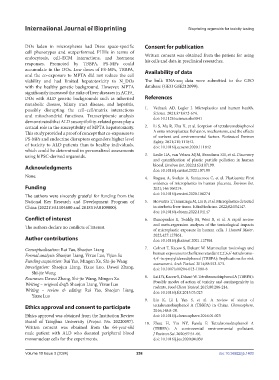Page 266 - IJB-10-3
P. 266
International Journal of Bioprinting Bioprinting organoids for toxicity testing
DOs laden in microspheres had Disse space-specific Consent for publication
cell phenotypes and outperformed PHHs in terms of
endocytosis, cell–ECM interactions, and hormone Written consent was obtained from the patient for using
responses. Promoted by TBBPA, PS-MPs could his cells and data in preclinical researches.
accumulate in the DOs. Low doses of PS-MPs, TBBPA, Availability of data
and the co-exposure to MPTA did not reduce the cell
viability and had limited hepatotoxicity to N_DOs The bulk RNA-seq data were submitted to the GEO
with the healthy genetic background. However, MPTA database (GEO GSE212099).
significantly increased the risks of liver diseases in AC19_
DOs with ALD genetic backgrounds such as inherited References
metabolic disease, biliary tract disease, and hepatitis,
possibly disrupting the cell–cell/matrix interactions 1. Vethaak AD, Legler J. Microplastics and human health.
and mitochondrial functions. Transcriptomic analysis Science. 2021;371:672-674.
doi: 10.1126/science.abe5041
demonstrated that ALD susceptibility-related genes play a
critical role in the susceptibility of MPTA hepatotoxicity. 2. Li S, Ma R, Zhu X, et al. Sorption of tetrabromobisphenol
This study provided a proof of concept that co-exposure to A onto microplastics: Behavior, mechanisms, and the effects
PS-MPs and endocrine disruptors engenders higher level of sorbent and environmental factors. Ecotoxicol Environ
Safety. 2021;210:111842.
of toxicity to ALD patients than to healthy individuals, doi: 10.1016/j.ecoenv.2020.111842
which could be determined in personalized assessments
using hiPSC-derived organoids. 3. Leslie HA, van Velzen MJM, Brandsma SH, et al. Discovery
and quantification of plastic particle pollution in human
Acknowledgments blood. Environ Int. 2022;163:107199.
doi: 10.1016/j.envint.2022.107199
None. 4. Ragusa A, Svelato A, Santacroce C, et al. Plasticenta: First
evidence of microplastics in human placenta. Environ Int.
Funding 2021;146:106274.
The authors were sincerely grateful for funding from the doi: 10.1016/j.envint.2020.106274
National Key Research and Development Program of 5. Horvatits T, Tamminga M, Liu B, et al. Microplastics detected
China (2022YFA1104600 and 2018YFA0109000). in cirrhotic liver tissue. EBioMedicine. 2022;82:104147.
doi: 10.1016/j.ebiom.2022.104147
Conflict of interest 6. Danopoulos E, Twiddy M, West R, et al. A rapid review
and meta-regression analyses of the toxicological impacts
The authors declare no conflicts of interest.
of microplastic exposure in human cells. J Hazard Mater.
2022;427:127861.
Author contributions doi: 10.1016/j.jhazmat.2021.127861
Conceptualization: Rui Yao, Shaojun Liang 7. Colnot T, Kacew S, Dekant W. Mammalian toxicology and
Formal analysis: Shaojun Liang, Yixue Luo, Yijun Su human exposures to the flame retardant 2,2’,6,6’-tetrabromo-
4,4’-isopropylidenediphenol (TBBPA): Implications for risk
Funding acquisition: Rui Yao, Mingen Xu, Shi-jie Wang assessment. Arch Toxicol. 2014;88:553-573.
Investigation: Shaojun Liang, Yixue Luo, Dawei Zhang, doi: 10.1007/s00204-013-1180-8
Shi-jie Wang
Resources: Dawei Zhang, Shi-jie Wang, Mingen Xu 8. Lai DY, Kacew S, Dekant W. Tetrabromobisphenol A (TBBPA):
Writing – original draft: Shaojun Liang, Yixue Luo Possible modes of action of toxicity and carcinogenicity in
rodents. Food Chem Toxicol. 2015;80:206-214.
Writing – review & editing: Rui Yao, Shaojun Liang, doi: 10.1016/j.fct.2015.03.023
Yixue Luo
9. Liu K, Li J, Yan S, et al. A review of status of
Ethics approval and consent to participate tetrabromobisphenol A (TBBPA) in China. Chemosphere.
2016;148:8-20.
Ethics approval was obtained from the Institution Review doi: 10.1016/j.chemosphere.2016.01.023
Board of Tsinghua University (Project No. 20220097). 10. Zhou H, Yin NY, Faiola F. Tetrabromobisphenol A
Written consent was obtained from the 64-year-old (TBBPA): A controversial environmental pollutant.
male patient with ALD who donated peripheral blood J Environ Sci. 2020;97:54-66.
mononuclear cells for the experiments. doi: 10.1016/j.jes.2020.04.039
Volume 10 Issue 3 (2024) 258 doi: 10.36922/ijb.1403

